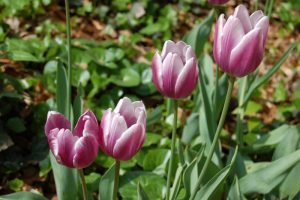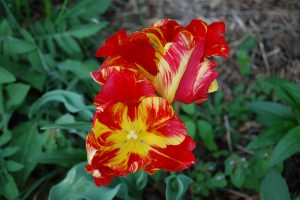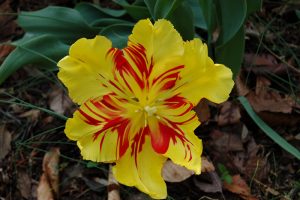If thinking about the end of summer is getting you down, it’s time to plan and plant your spring flowering bulb show. Autumn is the time to plant crocus, daffodils, tulips and many other spring bloomers.
Spring flowering bulbs are planted in the fall to allow them to establish roots before top growth begins in spring. Planting too early may cause the bulbs to sprout this fall, only to be killed back by winter weather. Planting too late may not give the bulbs adequate time to root before winter. Bulbs should be planted in late September through mid-October throughout most of Indiana.
 Fall planting also ensures adequate chilling of the bulbs to promote flower bud initiation. Most species require 10-12 weeks of storage at 40-50º F.
Fall planting also ensures adequate chilling of the bulbs to promote flower bud initiation. Most species require 10-12 weeks of storage at 40-50º F.
Start your bulb garden out on the right path by planting only quality bulbs available from local garden centers or reputable online/mail order sources. It’s best to shop early to ensure the best selection of variety and quality. Select large, firm bulbs, and avoid those that are sprouting or molding.
 While many bulbs can adapt to a wide range of soil types, none can tolerate poorly drained soil. Prepare the planting bed by adding organic matter, such as peat moss, well-rotted manure or compost. Depending on the specific site conditions, you may or may not need to add additional fertilizer. A soil test ahead of planting will determine needs for that site. Mix all amendments thoroughly with the soil in the bed before you plant the bulbs.
While many bulbs can adapt to a wide range of soil types, none can tolerate poorly drained soil. Prepare the planting bed by adding organic matter, such as peat moss, well-rotted manure or compost. Depending on the specific site conditions, you may or may not need to add additional fertilizer. A soil test ahead of planting will determine needs for that site. Mix all amendments thoroughly with the soil in the bed before you plant the bulbs.
The size of the bulb and the species will dictate the proper planting depth and spacing, generally the depth should be approximately 2.5-3 times the diameter of the bulb at its widest. Purchased bulbs should come with planting instructions specific to that particular species.
For more information on the many types of bulbs that can be grown in Indiana, you can download a copy of HO-86 “Flowering Bulbs” from http://www.hort.purdue.edu/ext/HO-86.pdf.
